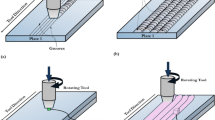Conclusions
We investigated the relationship between thermal conductivity, specific heat, and temperature conductivity of fused silica ceramics with a true porosity of 1.5–28%, and temperature. Above 500°C we detected a sharp deviation in the thermal conductivity of fused silica ceramics from this factor recorded for fused silica. The deviation is explained by the presence of straight-through radiant heat currents during the tests of the fused silica.
We established a linear relationship between static and dynamic elasticity modulus and porosity, but could not detect a relationship for temperature.
We investigated the relationship between the most probable bending strength value and porosity. This relationship can be described by the exponent with an accuracy of up to 4%.
Similar content being viewed by others
Literature cited
O. N. Botvinkin and A. I. Zaporozhskii, Fused Quartz [in Russian], Stroiizdat (1965).
P. P. Budnikov and Yu. E. Pivinskii, Uspekhi Khimii,36, No. 3, 514 (1967).
N. I. Voronin and R. S. Churakova, Ogneupory, No. 1, 47 (1967).
I. E. Nishanova et al., in: Highly Refractory Materials [in Russian], Metallurgiya, (1966), p. 82.
R. Ya. Popil'skii and I. E. Nishanova, Trans. D. I. Mendeleev Moscow Institute of Chemical Technology, No. 50, 195 (1966).
J. D. Fleminy, Amer. Ceram. Soc. Bull.,40, 748 (1961).
R. E. Gannon et al., Amer. Ceram. Soc. Bull.,44, 460 (1965).
W. Schulle, Silikattechnik,13, 282 (1962).
W. Schulle and J. Ulbricht, Silikattechnik,13, 229 (1962).
J. D. Walton, Ceramic Age,76, No. 2, 33 (1960); No. 3, 23 (1960).
B. N. Oleinik, Teplofizika Vysokikh Temperatur,2, No. 1, 109 (1964).
G. L. Hanford, Infrared Radiation [Russian translation], Énergiya (1964), p. 23.
R. Borkhert and V. Yubits, Infrared Heating Techniques [Russian translation], Gosénergoizdat (1963), p. 76.
Ch. Kittel, Elementary Physics of Solids [in Russian], Izd-vo Nauka (1965), p. 59.
E. M. Voronkov et al., Optical Materials for Infrared Techniques [in Russian], Manual, Nauka (1965), p. 144.
B. A. Chandler and E. C. Duderstand, J. Nuclear Materials,8, No. 3, 276 (1963).
F. T. Gorobets and Yu. E. Pivinskii, Ogneupory, No. 8, 45 (1968).
Additional information
Translated from Ogneupory, No. 9, pp. 58–63, September, 1968.
Rights and permissions
About this article
Cite this article
Romashin, A.G., Pivinskii, Y.E. Properties of fused silica ceramics. Refractories 9, 590–595 (1968). https://doi.org/10.1007/BF01283506
Issue Date:
DOI: https://doi.org/10.1007/BF01283506



